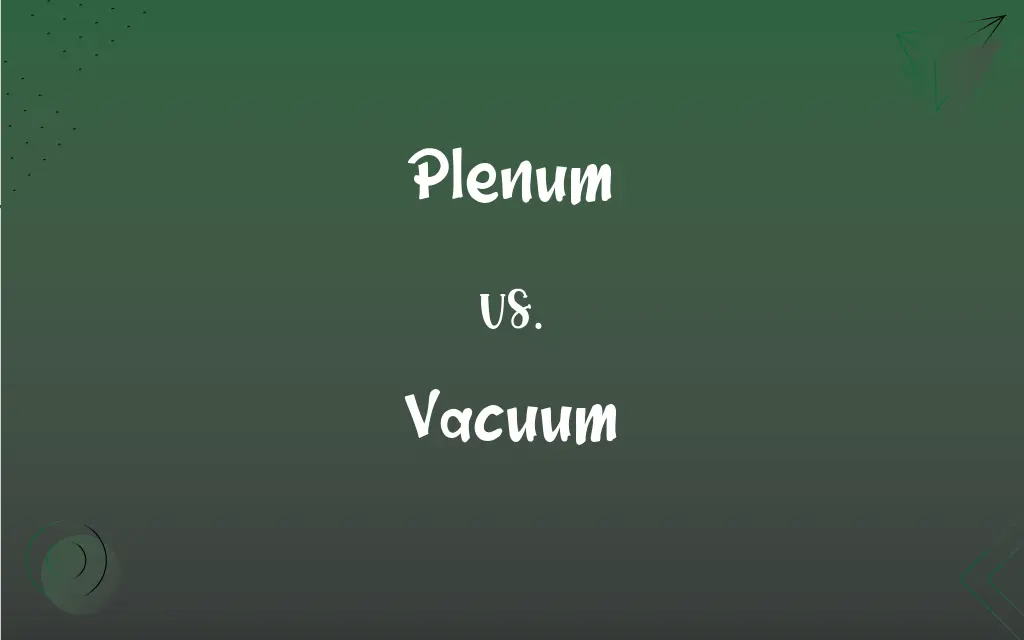Plenum vs. Vacuum: What's the Difference?
By Harlon Moss & Aimie Carlson || Updated on May 22, 2024
A plenum is a space filled with air or fluid at positive pressure, while a vacuum is a space with extremely low pressure, often devoid of air.

Key Differences
A plenum is an area, often within buildings or machines, filled with air or fluid under pressure. This pressured environment facilitates ventilation and airflow management. Conversely, a vacuum is characterized by a near-absence of matter, typically achieved by removing air to create a low-pressure environment.
In HVAC systems, plenums are used to distribute conditioned air throughout a building, whereas vacuums are utilized in processes requiring the absence of air, such as certain manufacturing or scientific applications. While plenums rely on positive pressure to function, vacuums depend on the maintenance of significantly reduced pressure.
Air distribution in plenums ensures efficient cooling or heating, often through ducts. On the other hand, vacuums are employed in vacuum-sealed packaging or electron microscopy, where the lack of air prevents contamination or interference. The purpose of a plenum is to manage and direct airflow, whereas a vacuum is used to eliminate air and other particles from a designated space.
The construction of a plenum involves sealing spaces to contain pressurized air. Conversely, creating a vacuum requires a sealed environment from which air is actively removed. Plenums contribute to maintaining indoor air quality, while vacuums serve in preserving perishable goods by preventing oxidation and spoilage.
Comparison Chart
Definition
Space with air or fluid at positive pressure
Space with extremely low pressure
ADVERTISEMENT
Usage
HVAC systems, airflow management
Scientific research, packaging, electronics
Pressure Level
Positive pressure
Low or negative pressure
Environment
Contains air or fluid
Near-absence of matter
Functionality
Distributes air
Removes air and particles
Plenum and Vacuum Definitions
Plenum
An enclosure in which air or gas is at a higher pressure than the outside atmosphere.
The plenum chamber ensures consistent air pressure.
ADVERTISEMENT
Vacuum
A condition of significantly reduced pressure.
The vacuum inside the bell jar allowed for precise measurements.
Plenum
A space filled with air under pressure.
The HVAC system uses a plenum to distribute air throughout the building.
Vacuum
A space devoid of matter or with very low pressure.
The laboratory created a vacuum for the experiment.
Plenum
An air-filled space in a duct system.
The plenum box connects to the ductwork.
Vacuum
An empty space where air has been removed.
The vacuum seal kept the food fresh.
Plenum
A compartment or chamber with a controlled positive pressure.
The plenum maintains airflow in the ventilation system.
Vacuum
An environment with minimal or no air.
Vacuum packaging extends the shelf life of products.
Plenum
An assembly or meeting with all members present.
Vacuum
An artificially created low-pressure area.
The vacuum pump was used to evacuate the chamber.
Plenum
A condition, space, or enclosure in which air or other gas is at a pressure greater than that of the outside atmosphere.
Vacuum
Absence of matter.
Plenum
The condition of being full; fullness.
Vacuum
A space empty of matter.
Plenum
A space completely filled with matter.
Vacuum
A space relatively empty of matter.
Plenum
A space lying above the ceiling in a building but below the next floor, especially one allowing movement of air between parts of the building.
Vacuum
A space in which the pressure is significantly lower than atmospheric pressure.
Plenum
(physics) A space that is completely filled with matter.
Vacuum
A state of emptiness; a void.
Plenum
(figuratively) A state of fullness, a great quantity (of something).
Vacuum
A state of being sealed off from external or environmental influences; isolation.
Plenum
A legislative meeting (especially of the Communist Party) in which all members are present.
Vacuum
Pl. vac·uums A vacuum cleaner.
Plenum
An enclosed space having greater than atmospheric pressure.
Vacuum
Of, relating to, or used to create a vacuum.
Plenum
The space above a false ceiling used for cables, ducts etc.
Vacuum
Containing air or other gas at a reduced pressure.
Plenum
(computing) A type of network cabling which satisfies plenum-ratings issued by the National Electrical Code. These cables produce less smoke and fumes in the event of fire.
Vacuum
Operating by means of suction or by maintaining a partial vacuum.
Plenum
That state in which every part of space is supposed to be full of matter; - opposed to vacuum.
Vacuum
To clean with or use a vacuum cleaner.
Plenum
A condition, as in an occupied room, in which the pressure of the air is greater than that of the outside atmosphere; as, a plenum may exist in a hall ventilated by a fan blower.
Vacuum
A region of space that contains no matter.
Plenum
A meeting of a legislative body at which all members are present;
The plenum will vote on all tax increases
Vacuum
A vacuum cleaner.
Plenum
An enclosed space in which the air pressure is higher than outside
Vacuum
The condition of rarefaction, or reduction of pressure below that of the atmosphere, in a vessel, such as the condenser of a steam engine, which is nearly exhausted of air or steam, etc.
A vacuum of 26 inches of mercury, or 13 pounds per square inch
Plenum
A part of a building where conditioned air is forced.
Air is directed into the rooms from the plenum above the ceiling.
Vacuum
(physics) A spacetime having tensors of zero magnitude.
Vacuum
An emptiness in life created by a loss of a person who was close, or of an occupation.
Vacuum
(transitive) To clean (something) with a vacuum cleaner.
Vacuum
(intransitive) To use a vacuum cleaner.
Vacuum
To optimise a database or database table by physically removing deleted tuples.
Vacuum
A space entirely devoid of matter (called also, by way of distinction, absolute vacuum); hence, in a more general sense, a space, as the interior of a closed vessel, which has been exhausted to a high or the highest degree by an air pump or other artificial means; as, water boils at a reduced temperature in a vacuum.
Vacuum
The condition of rarefaction, or reduction of pressure below that of the atmosphere, in a vessel, as the condenser of a steam engine, which is nearly exhausted of air or steam, etc.; as, a vacuum of 26 inches of mercury, or 13 pounds per square inch.
Vacuum
The absence of matter
Vacuum
An empty area or space;
The huge desert voids
The emptiness of outer space
Without their support he'll be ruling in a vacuum
Vacuum
A region empty of matter
Vacuum
An electrical home appliance that cleans by suction
Vacuum
Clean with a vacuum cleaner;
Vacuum the carpets
FAQs
What is a plenum in HVAC systems?
A plenum is a compartment used to distribute air within a building's HVAC system.
Why is positive pressure important in a plenum?
Positive pressure in a plenum ensures effective distribution and flow of air through ducts.
How is a vacuum created?
A vacuum is created by using pumps to remove air from a sealed environment.
What are common uses of a vacuum?
Vacuums are used in scientific research, vacuum packaging, and electronics.
What is the role of a vacuum in manufacturing?
Vacuums remove air and contaminants, crucial for processes like semiconductor manufacturing.
What industries use vacuum technology?
Industries like food packaging, electronics, and aerospace rely on vacuum technology.
Can you feel the air pressure in a plenum?
Generally, no, but the pressure is controlled and consistent for airflow management.
How does a vacuum differ from a plenum?
A vacuum has extremely low pressure and little to no air, while a plenum is an area with air under positive pressure.
What materials are used to construct plenums?
Plenums are often constructed from metal or rigid plastic to contain pressurized air.
Can a plenum be part of a vacuum system?
Typically, no. Plenums and vacuums serve different purposes and operate under opposite pressure conditions.
Do plenum spaces require maintenance?
Yes, to ensure they remain sealed and free from obstructions for efficient airflow.
What safety measures are needed for vacuum systems?
Proper sealing, monitoring of pressure levels, and ensuring pump efficiency are crucial.
What happens if a vacuum seal fails?
The environment would revert to atmospheric pressure, potentially contaminating the contents.
Can a plenum be located anywhere in a building?
It’s typically placed above ceilings or below floors for efficient air distribution.
Is a vacuum completely empty of air?
Not entirely; it's a space with significantly reduced air pressure.
What are vacuum pumps used for?
They remove air to create a vacuum in a designated space.
Why are plenums important in cleanrooms?
They help maintain a controlled and clean airflow environment.
Are plenums always part of HVAC systems?
Primarily, but they can also be found in other applications requiring controlled airflow.
What is the benefit of using a vacuum in food packaging?
It extends shelf life by preventing oxidation and spoilage.
Can vacuums be naturally occurring?
Yes, outer space is an example of a natural vacuum.
About Author
Written by
Harlon MossHarlon is a seasoned quality moderator and accomplished content writer for Difference Wiki. An alumnus of the prestigious University of California, he earned his degree in Computer Science. Leveraging his academic background, Harlon brings a meticulous and informed perspective to his work, ensuring content accuracy and excellence.
Co-written by
Aimie CarlsonAimie Carlson, holding a master's degree in English literature, is a fervent English language enthusiast. She lends her writing talents to Difference Wiki, a prominent website that specializes in comparisons, offering readers insightful analyses that both captivate and inform.
































































